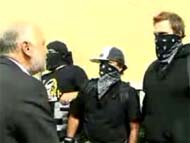When the North American Summit Leaders’ Summit was held in Montebello, Quebec in August 2007, something came to the attention of Dave Coles, President of the Communications, Energy and Paperworkers Union.
Amidst a seemingly peaceful protest, Coles noticed that three bandana-clad “burly” men were attempting to incite the protestors to become violent toward riot police.

As with many of these situations at the national level, the R.C.M.P. has jurisdiction or control if you will over security, however, then Minister of Public Safety Stockwell Day indicated that security on the front line and directed toward controlling the protesters was the responsibility of Quebec’s provincial police agency, the Sureté du Québec.  That in my opinion, is fairly normal.
What Mr. Coles charged is that the three burly men were actually police officers.  This seems to go against the rationale to what the police were there to do.  To quell violence not insight it.  After concluding in quickie internal investigation there was no wrongdoing, the Comité à la déontologie policière said yesterday in a media release there was grounds to believe wrongdoing occurred on the part of the officers, and has now summoned them to a hearing on the matter.
Now the committee, which has the power to issue binding rulings on the Quebec police, will hold public hearings on the issue within the next six months. The three officers – Jean-François Boucher, Joey Laflamme and Patrick Tremblay – are required to appear – The Globe and Mail reports.
Aside from the obvious disciplinary sanctions that these officers now potentially face. Â Mr. Coles and many like him are asking the tough question of who directed these officers to take such action? Â Accountability needs to be had in order to restore faith in the public’s perception of how the police handle these situations.
Like one of my other articles, (also found here), I have the fortunate ability to break this down as a former police officer, who was also part of the York Regional Police’s Public Order Unit.  Just to qualify my skills, I receive basic Public Order training at Downsview park with the Toronto Police Service’s Public Order Unit, and did requalification training at C.F.B. Meaford with a number of Ontario police agencies.  I was also deployed to Caledonia at the height of the tension between the First Nations people and local residents.
In my training we were taught how to deal with such situations and my superiors would have never instructed officers to take up such actions. Â Just as the protestors arms themselves with video cameras and other “weapons” of technology, so do the police. Â In such public order situations, there could be plainclothes officers in the crowd monitoring situations, recording for evidentiary purposes, and watching certain groups known to police to cause problems. Â Nothing wrong with that.
But the thought that the police were the ones instigating the problems is quite saddening.  I hope justice is swift, and those responsible, whether it is the Sûreté du Québec, R.C.M.P., or politicians are able to dealt with appropriately, especially after watching the YouTube video:
And hearing all of the evidence the Committee has ruled in the following manner:
ALLOWS the application for review in respect of the three respondent
sergeants on the allegations stated by the Commissioner in his decision:
Was disrespectful or impolite towards any person (section 5 of the Code);
Used obscene, blasphemous or abusive language (section 5 of the Code);
8 Item 4.10 of the Commissioner’s investigation report.Failed to respect the authority of the law by inciting persons to violence (section 7 of the Code);
Refused to produce identification when a person asked him to do so (section 6 of the Code);
Furthermore, now that the Committee has overruled the Commissioner, the door has probably been opened for a criminal investigation in relation to assault charges against one officer, and potentially this:
Unlawful Assembly:
63. (1) An unlawful assembly is an assem- bly of three or more persons who, with intent to carry out any common purpose, assemble in such a manner or so conduct themselves when they are assembled as to cause persons in the neighbourhood of the assembly to fear, on rea- sonable grounds, that they
(a) will disturb the peace tumultuously; or
(b) will by that assembly needlessly and without reasonable cause provoke other per- sons to disturb the peace tumultuously.
(2) Persons who are lawfully assembled may become an unlawful assembly if they conduct themselves with a common purpose in a man- ner that would have made the assembly unlaw- ful if they had assembled in that manner for that purpose.
Like all interesting developing stories, we shall see where this leads us.

I wish to thank you for your very informative blogpost–especially from your point of view as a former police officer.
Does anyone rally believe that three cops could decide to infiltrate the protest without their chain of command knowing what was going down? The front guys are taking the rap for the brass (again).
Sure these cops were infiltrators.. but this doesn’t mean that the protest would have stayed peaceful without them.. not everybody present in montebello were followers of pathological pacifism, an many were prepared for self-defense when the uniformed police officers attacked us. It wasn’t just provocateurs who were carrying rocks. Many victims of the police’s chemical weapons picked up rocks and other objects and hurled them back at the pigs, and they were totally justified in doing this.
Police are still infiltrating our ranks outside of protests.. this is the real problem. This whole outing of police provocateurs seems staged to disuade people away from militant tactics.. maybe the point was to get caught so that people at future demos dont support those who believe in a diversity of tactics and makes people think every black-clad militant protester is a provocateur..